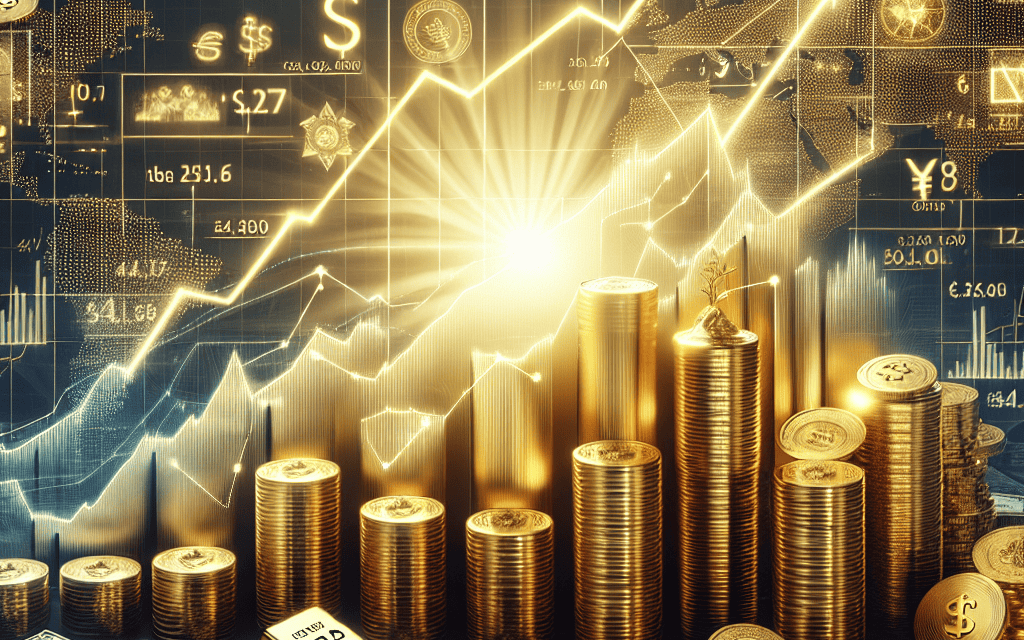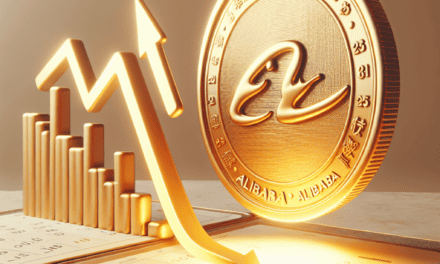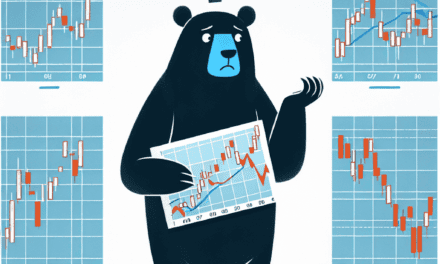“Unlocking Wealth: The Timeless Allure of Gold Investment”
Introduction
In recent years, gold has re-emerged as a dominant force in the global investment landscape, captivating the attention of investors worldwide. This precious metal, long revered for its intrinsic value and historical significance, is experiencing a renaissance driven by economic uncertainty, geopolitical tensions, and evolving market dynamics. As traditional financial instruments face volatility and diminishing returns, gold’s allure as a safe-haven asset and a hedge against inflation has intensified. The rise of gold as a top global investment trend underscores a broader shift in investor sentiment, highlighting a growing preference for tangible assets that offer stability and security in an unpredictable world. This trend is not only reshaping portfolios but also influencing the strategies of central banks, financial institutions, and individual investors alike, marking a new era in the pursuit of wealth preservation and growth.
Historical Context: Understanding Gold’s Enduring Value
Gold has long been regarded as a symbol of wealth and prosperity, its allure transcending cultures and epochs. To understand its enduring value, one must delve into the historical context that has shaped its status as a top global investment trend. For millennia, gold has been coveted not only for its intrinsic beauty but also for its rarity and durability. These attributes have made it a preferred medium of exchange and a reliable store of value, especially in times of economic uncertainty.
Tracing back to ancient civilizations, gold was used in trade and as a measure of wealth. The Egyptians, for instance, revered gold for its divine qualities, associating it with the eternal and the celestial. Similarly, in ancient Rome and Greece, gold coins were minted as currency, facilitating trade across vast empires. This historical precedent established gold as a universal standard of value, a role it continues to play in the modern financial system.
As we transition into the medieval period, gold’s significance only grew. The establishment of the gold standard in the 19th century further cemented its role in global finance. Under this system, currencies were directly linked to gold, providing a stable foundation for international trade. Although the gold standard was eventually abandoned in the 20th century, the legacy of gold as a benchmark for economic stability persisted. This historical backdrop underscores why gold remains a sought-after asset, particularly during periods of inflation or geopolitical tension.
In contemporary times, gold’s appeal as an investment has been bolstered by its performance during financial crises. For instance, during the 2008 global financial meltdown, gold prices surged as investors sought refuge from volatile stock markets and depreciating currencies. This pattern was repeated during the COVID-19 pandemic, when economic uncertainty drove investors to seek the safety of gold, pushing its prices to record highs. Such trends highlight gold’s role as a hedge against economic instability, reinforcing its status as a reliable investment.
Moreover, the rise of emerging markets has further fueled demand for gold. In countries like China and India, where cultural traditions place a high value on gold, rising incomes have led to increased consumption of gold jewelry and investment products. This growing demand from populous nations has had a significant impact on global gold markets, driving prices upward and attracting the attention of international investors.
In addition to its traditional uses, gold’s role in technology and industry has expanded its appeal. Gold’s excellent conductivity and resistance to corrosion make it indispensable in electronics, from smartphones to sophisticated medical devices. This industrial demand adds another layer of value to gold, diversifying its investment potential beyond mere speculation.
In conclusion, the historical context of gold’s enduring value is a testament to its multifaceted appeal. From ancient civilizations to modern financial markets, gold has consistently been a symbol of wealth and a safeguard against economic uncertainty. Its unique properties, coupled with its historical significance, continue to make it a top global investment trend. As investors navigate the complexities of the modern economy, gold’s timeless allure remains a beacon of stability and prosperity.
Economic Uncertainty: Why Gold Shines in Volatile Markets
In times of economic uncertainty, investors often seek refuge in assets that promise stability and security. Among these, gold has consistently emerged as a preferred choice, shining brightly in volatile markets. The allure of gold as a safe-haven asset is not a new phenomenon; it has been a trusted store of value for centuries. However, recent global economic trends have further cemented its status as a top investment option. As economies around the world grapple with challenges such as inflation, geopolitical tensions, and fluctuating currencies, gold’s appeal has only grown stronger.
One of the primary reasons gold remains a favored investment during economic turbulence is its intrinsic value. Unlike fiat currencies, which can be subject to devaluation and inflation, gold maintains its worth over time. This characteristic makes it an attractive hedge against inflation, a concern that has been particularly pronounced in recent years. As central banks around the world have implemented expansive monetary policies to stimulate growth, the resulting increase in money supply has raised fears of inflationary pressures. In such an environment, gold’s ability to preserve purchasing power becomes especially valuable.
Moreover, gold’s performance is often inversely correlated with the performance of traditional financial markets. When stock markets experience downturns, investors tend to flock to gold, driving up its price. This inverse relationship is rooted in the perception of gold as a safe-haven asset, providing a buffer against market volatility. As a result, during periods of economic instability, gold often outperforms other asset classes, offering investors a reliable means of diversification.
In addition to its role as a hedge against inflation and market volatility, gold also benefits from its status as a global currency. Unlike other commodities, gold is universally recognized and accepted, making it a highly liquid asset. This liquidity is particularly advantageous in times of crisis, when investors may need to quickly convert their holdings into cash. Furthermore, gold’s universal appeal transcends cultural and geographic boundaries, ensuring its demand remains robust across different regions.
The geopolitical landscape also plays a significant role in bolstering gold’s appeal. In times of political uncertainty or conflict, gold is often seen as a stable store of value. For instance, tensions between major global powers or instability in key regions can lead to increased demand for gold as investors seek to mitigate risk. This dynamic was evident during the recent geopolitical tensions in Eastern Europe and the Middle East, where gold prices surged as investors sought safety.
While gold’s historical performance and intrinsic qualities make it an attractive investment, it is important for investors to consider the potential risks and challenges associated with investing in this precious metal. Gold prices can be influenced by a variety of factors, including changes in interest rates, currency fluctuations, and shifts in investor sentiment. Therefore, while gold can provide stability in uncertain times, it should be viewed as part of a diversified investment portfolio rather than a standalone solution.
In conclusion, the rise of gold as a top global investment trend is a testament to its enduring appeal in the face of economic uncertainty. Its ability to act as a hedge against inflation, provide diversification, and serve as a global currency makes it a valuable asset in volatile markets. As investors navigate the complexities of the modern economic landscape, gold’s timeless allure continues to shine brightly, offering a beacon of stability in an ever-changing world.
Gold vs. Cryptocurrency: A Comparative Analysis
In recent years, the investment landscape has witnessed a significant shift, with gold and cryptocurrency emerging as prominent contenders for investors seeking to diversify their portfolios. As traditional investment vehicles face increasing volatility, the allure of these alternative assets has grown. To understand the dynamics of this trend, it is essential to conduct a comparative analysis of gold and cryptocurrency, examining their respective advantages and challenges.
Gold, a time-honored asset, has been a symbol of wealth and stability for centuries. Its intrinsic value and historical significance make it a reliable store of value, particularly during times of economic uncertainty. Investors often turn to gold as a hedge against inflation and currency devaluation, given its ability to maintain purchasing power over the long term. Furthermore, gold’s physical nature provides a tangible asset that can be held and stored, offering a sense of security that digital assets may lack.
In contrast, cryptocurrency represents a modern frontier in the investment world, characterized by its digital nature and decentralized framework. Bitcoin, the most well-known cryptocurrency, has gained significant traction as a potential alternative to traditional currencies. Its appeal lies in its limited supply, which mimics the scarcity of gold, and its potential for high returns. Moreover, the blockchain technology underpinning cryptocurrencies offers transparency and security, features that are increasingly valued in today’s digital age.
Despite these advantages, both gold and cryptocurrency present unique challenges. Gold, while stable, does not offer the same potential for rapid appreciation as cryptocurrencies. Its price movements are often influenced by geopolitical events and central bank policies, which can introduce elements of unpredictability. Additionally, the costs associated with storing and insuring physical gold can be prohibitive for some investors.
On the other hand, cryptocurrency is notorious for its volatility. The rapid price fluctuations can lead to significant gains, but also substantial losses. Regulatory uncertainty further complicates the landscape, as governments around the world grapple with how to classify and control these digital assets. Moreover, the security of cryptocurrency exchanges has been a concern, with high-profile hacks resulting in the loss of millions of dollars.
Despite these challenges, the rise of gold and cryptocurrency as investment trends reflects a broader shift in investor sentiment. As global economic conditions evolve, the desire for assets that offer diversification and protection against traditional market risks has intensified. Gold and cryptocurrency, while distinct in their characteristics, both serve this purpose, albeit in different ways.
In conclusion, the comparative analysis of gold and cryptocurrency reveals a complex interplay of factors that investors must consider. Gold’s historical stability and intrinsic value make it a steadfast choice for those seeking a reliable store of wealth. Meanwhile, cryptocurrency’s potential for high returns and innovative technology appeals to those willing to embrace risk for the possibility of substantial rewards. As the investment landscape continues to evolve, understanding the nuances of these assets will be crucial for investors aiming to navigate the complexities of the modern financial world. Ultimately, the decision to invest in gold, cryptocurrency, or a combination of both will depend on individual risk tolerance, investment goals, and the broader economic context.
Central Banks and Gold Reserves: A Strategic Asset

In recent years, the global financial landscape has witnessed a significant shift in the strategies employed by central banks, with gold emerging as a pivotal component of their asset portfolios. This trend underscores the growing recognition of gold as a strategic asset, offering stability and security in an increasingly volatile economic environment. As central banks navigate the complexities of global markets, the accumulation of gold reserves has become a key strategy to mitigate risks and enhance financial resilience.
Historically, gold has been revered for its intrinsic value and its role as a hedge against inflation and currency fluctuations. In times of economic uncertainty, gold’s appeal as a safe haven asset becomes particularly pronounced. Central banks, tasked with maintaining economic stability and safeguarding national currencies, have thus turned to gold as a reliable store of value. This strategic move is not merely a reaction to short-term market dynamics but rather a long-term approach to fortifying national financial systems.
The rise in gold reserves among central banks can be attributed to several factors. Firstly, the geopolitical landscape has become increasingly unpredictable, with trade tensions, political instability, and economic sanctions posing significant challenges. In such a climate, gold offers a level of security that fiat currencies and other financial instruments cannot match. By diversifying their reserves with gold, central banks can reduce their reliance on any single currency, thereby minimizing exposure to geopolitical risks.
Moreover, the global monetary policy environment has played a crucial role in the resurgence of gold as a strategic asset. In the aftermath of the 2008 financial crisis, central banks around the world adopted unprecedented measures, including quantitative easing and near-zero interest rates, to stimulate economic growth. While these policies have been effective in certain respects, they have also led to concerns about currency devaluation and inflationary pressures. Gold, with its historical reputation as a hedge against inflation, has thus become an attractive option for central banks seeking to preserve the purchasing power of their reserves.
In addition to these macroeconomic considerations, the technological advancements in gold trading and storage have facilitated its integration into central bank portfolios. The development of more efficient and secure methods for buying, selling, and storing gold has made it easier for central banks to manage their gold reserves. This increased accessibility has further bolstered gold’s status as a strategic asset, enabling central banks to respond swiftly to changing market conditions.
Furthermore, the diversification benefits of gold cannot be overstated. As central banks strive to optimize their asset allocations, gold provides a unique opportunity to enhance portfolio diversification. Its low correlation with other asset classes, such as equities and bonds, means that gold can help reduce overall portfolio volatility. This characteristic is particularly valuable in times of financial market turbulence, where traditional assets may experience significant fluctuations.
In conclusion, the rise of gold as a top global investment trend among central banks reflects a strategic shift towards greater financial security and stability. By incorporating gold into their reserves, central banks are better equipped to navigate the complexities of the modern economic landscape. As geopolitical uncertainties persist and monetary policies evolve, the role of gold as a strategic asset is likely to remain a cornerstone of central bank strategies worldwide. This trend not only highlights the enduring value of gold but also underscores its importance in shaping the future of global financial systems.
Technological Advancements: Gold in the Digital Age
In recent years, the investment landscape has witnessed a significant shift, with gold emerging as a top global investment trend. This precious metal, long revered for its intrinsic value and historical significance, is now experiencing a renaissance, driven in part by technological advancements that have redefined its role in the digital age. As investors seek stability amidst economic uncertainties, gold’s allure has been further enhanced by innovations that make it more accessible and versatile than ever before.
One of the most notable technological advancements in the realm of gold investment is the advent of digital gold platforms. These platforms allow investors to buy, sell, and store gold electronically, eliminating the need for physical possession. This innovation has democratized gold investment, making it accessible to a broader audience who may have previously been deterred by the logistical challenges of storing and securing physical gold. By leveraging blockchain technology, digital gold platforms ensure transparency and security, providing investors with peace of mind and fostering trust in the digital gold ecosystem.
Moreover, the integration of gold with blockchain technology has paved the way for the creation of gold-backed cryptocurrencies. These digital assets are pegged to the value of gold, combining the stability of the precious metal with the flexibility and efficiency of cryptocurrencies. As a result, investors can now enjoy the benefits of both worlds, using gold-backed cryptocurrencies as a hedge against inflation while also taking advantage of the liquidity and ease of transfer associated with digital currencies. This fusion of traditional and modern investment vehicles exemplifies the transformative impact of technology on the gold market.
In addition to digital platforms and cryptocurrencies, technological advancements have also enhanced the efficiency of gold mining and refining processes. Innovations in mining technology have led to more sustainable and environmentally friendly practices, addressing concerns about the ecological impact of gold extraction. Advanced techniques such as bio-mining and the use of artificial intelligence in exploration have increased the yield and reduced the carbon footprint of gold mining operations. These developments not only contribute to the sustainability of the industry but also enhance the appeal of gold as an ethical investment choice.
Furthermore, technology has facilitated the development of sophisticated financial instruments linked to gold, such as exchange-traded funds (ETFs) and futures contracts. These instruments provide investors with diverse options to gain exposure to gold without the need for direct ownership. The ability to trade gold ETFs and futures on major exchanges has increased liquidity and reduced transaction costs, making gold a more attractive option for institutional and retail investors alike. As a result, gold has solidified its position as a key component of diversified investment portfolios.
In conclusion, the rise of gold as a top global investment trend is inextricably linked to technological advancements that have redefined its role in the digital age. From digital gold platforms and gold-backed cryptocurrencies to sustainable mining practices and innovative financial instruments, technology has enhanced the accessibility, efficiency, and appeal of gold as an investment. As the world continues to navigate economic uncertainties, the enduring value of gold, coupled with these technological innovations, ensures its continued prominence in the global investment landscape. As investors increasingly recognize the benefits of incorporating gold into their portfolios, the precious metal’s status as a safe haven and a symbol of wealth is poised to endure well into the future.
Environmental Impact: Sustainable Gold Mining Practices
The rise of gold as a top global investment trend has brought renewed attention to the environmental impact of gold mining practices. As investors increasingly seek sustainable and ethical investment opportunities, the gold mining industry faces mounting pressure to adopt environmentally responsible practices. This shift is not only driven by regulatory requirements but also by a growing awareness among consumers and investors about the environmental and social implications of gold extraction.
Traditionally, gold mining has been associated with significant environmental degradation, including deforestation, soil erosion, and water pollution. The use of toxic chemicals such as cyanide and mercury in the extraction process has further exacerbated these issues, posing serious risks to ecosystems and human health. However, in response to these challenges, the industry is gradually embracing more sustainable practices aimed at minimizing its environmental footprint.
One of the key strategies being implemented is the adoption of cleaner technologies that reduce the reliance on harmful chemicals. For instance, some mining companies are exploring the use of gravity-based separation techniques, which eliminate the need for cyanide and mercury. Additionally, advancements in bioleaching, a process that uses naturally occurring bacteria to extract gold from ore, offer a promising alternative that significantly reduces chemical usage and waste production.
Moreover, the industry is increasingly focusing on improving energy efficiency and reducing greenhouse gas emissions. Many mining operations are investing in renewable energy sources such as solar and wind power to meet their energy needs. This transition not only helps in reducing the carbon footprint of mining activities but also aligns with global efforts to combat climate change. Furthermore, the implementation of energy-efficient technologies and practices, such as the use of electric vehicles and equipment, is contributing to a more sustainable mining process.
In addition to technological advancements, sustainable gold mining practices also emphasize the importance of responsible land management and biodiversity conservation. Companies are now required to conduct comprehensive environmental impact assessments before commencing mining operations. These assessments help identify potential risks and develop strategies to mitigate them, ensuring that mining activities do not irreversibly damage local ecosystems. Reclamation and rehabilitation of mined land are also becoming standard practices, with companies investing in restoring vegetation and wildlife habitats once mining operations cease.
Community engagement and social responsibility are integral components of sustainable gold mining. Mining companies are increasingly recognizing the importance of building strong relationships with local communities and ensuring that they benefit from mining activities. This includes providing employment opportunities, supporting local infrastructure development, and investing in community health and education programs. By fostering positive relationships with communities, mining companies can enhance their social license to operate and contribute to the long-term sustainability of their operations.
While significant progress has been made, challenges remain in achieving truly sustainable gold mining practices. The industry must continue to innovate and collaborate with stakeholders, including governments, non-governmental organizations, and local communities, to address ongoing environmental and social concerns. Transparency and accountability are crucial in this regard, with companies being encouraged to disclose their environmental performance and sustainability initiatives.
In conclusion, the rise of gold as a top global investment trend has catalyzed a shift towards more sustainable mining practices. By adopting cleaner technologies, improving energy efficiency, and prioritizing community engagement, the gold mining industry is taking important steps towards reducing its environmental impact. As investors and consumers increasingly prioritize sustainability, the continued evolution of these practices will be essential in ensuring that gold remains a viable and responsible investment choice.
Investment Strategies: Diversifying Portfolios with Gold
In recent years, gold has emerged as a prominent player in the realm of global investment strategies, capturing the attention of both seasoned investors and newcomers alike. This precious metal, long revered for its intrinsic value and historical significance, is increasingly being recognized as a vital component in diversifying investment portfolios. As economic uncertainties and market volatilities continue to shape the financial landscape, the allure of gold as a stable and reliable asset has grown significantly. Consequently, understanding the dynamics behind this trend is essential for investors seeking to optimize their portfolios.
To begin with, gold’s enduring appeal lies in its ability to act as a hedge against inflation and currency fluctuations. Unlike paper currencies, which can be subject to devaluation, gold maintains its value over time, providing a sense of security for investors. This characteristic is particularly appealing during periods of economic instability, where traditional assets such as stocks and bonds may experience significant volatility. As central banks around the world continue to implement monetary policies that can lead to inflationary pressures, gold’s role as a safeguard against the erosion of purchasing power becomes increasingly relevant.
Moreover, gold’s performance during times of geopolitical tension further underscores its importance in a diversified portfolio. Historically, gold prices have tended to rise during periods of political unrest or conflict, as investors seek refuge in safe-haven assets. This inverse relationship with geopolitical risk makes gold an attractive option for those looking to mitigate potential losses in other areas of their portfolio. As global tensions persist, the strategic inclusion of gold can provide a buffer against unforeseen events that may impact financial markets.
In addition to its role as a protective asset, gold also offers diversification benefits that can enhance the overall risk-return profile of an investment portfolio. By incorporating gold, investors can reduce the correlation between their holdings, thereby minimizing the impact of market fluctuations on their overall wealth. This diversification is particularly valuable in today’s interconnected global economy, where market movements in one region can have far-reaching effects on others. As such, gold’s ability to provide a counterbalance to traditional asset classes is a compelling reason for its inclusion in a well-rounded investment strategy.
Furthermore, the accessibility of gold as an investment has improved significantly, making it easier for individuals to incorporate it into their portfolios. With the advent of exchange-traded funds (ETFs) and other investment vehicles, investors can now gain exposure to gold without the need to physically own the metal. This convenience, coupled with the transparency and liquidity offered by these instruments, has contributed to the growing popularity of gold as an investment choice.
In conclusion, the rise of gold as a top global investment trend is a testament to its enduring value and versatility as an asset. As investors navigate an increasingly complex financial landscape, the strategic inclusion of gold in their portfolios can provide a measure of stability and protection against various risks. By understanding the unique attributes of gold and its role in diversification, investors can make informed decisions that enhance their long-term financial security. As such, gold’s prominence in investment strategies is likely to continue, solidifying its status as a cornerstone of diversified portfolios worldwide.
Q&A
1. **What is “The Rise of Gold”?**
“The Rise of Gold” refers to the increasing interest and investment in gold as a valuable asset, driven by economic uncertainties, inflation concerns, and geopolitical tensions.
2. **Why is gold considered a top global investment trend?**
Gold is seen as a safe-haven asset that retains value over time, providing a hedge against inflation and currency devaluation, making it attractive during volatile economic periods.
3. **How has the price of gold changed recently?**
Gold prices have generally seen an upward trend due to increased demand from investors seeking stability amidst global economic challenges and market volatility.
4. **What factors contribute to the rise in gold investment?**
Key factors include economic instability, inflation fears, geopolitical tensions, low interest rates, and central banks’ monetary policies.
5. **Who are the major investors in gold?**
Major investors include central banks, institutional investors, hedge funds, and individual investors seeking portfolio diversification and risk management.
6. **What are the different ways to invest in gold?**
Investors can invest in physical gold (bullion, coins), gold ETFs, gold mining stocks, and gold futures and options.
7. **What are the potential risks of investing in gold?**
Risks include price volatility, storage and insurance costs for physical gold, and potential underperformance compared to other asset classes during certain economic conditions.
Conclusion
The rise of gold as a top global investment trend can be attributed to its historical role as a safe-haven asset, especially during times of economic uncertainty and geopolitical instability. As global markets face volatility, inflationary pressures, and currency fluctuations, investors increasingly turn to gold to preserve wealth and diversify portfolios. The metal’s intrinsic value, limited supply, and universal acceptance further bolster its appeal. Additionally, technological advancements and the growth of digital platforms have made gold more accessible to a broader range of investors. Consequently, gold’s prominence in investment strategies is likely to persist, reinforcing its status as a critical component of global financial markets.





